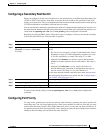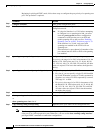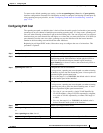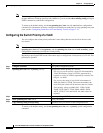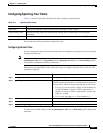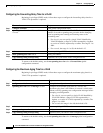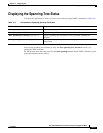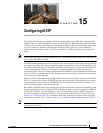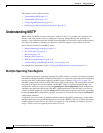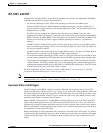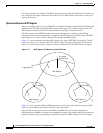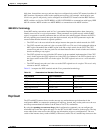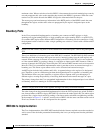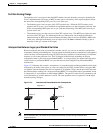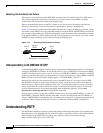
CHAPTER
15-1
Cisco ME 3400 Ethernet Access Switch Software Configuration Guide
OL-9639-06
15
Configuring MSTP
This chapter describes how to configure the Cisco implementation of the IEEE 802.1s Multiple STP
(MSTP) on the Cisco ME 3400 Ethernet Access switch. On the Cisco
ME switch, user network interfaces
(UNIs) on the switch do not participate in STP and immediately forward traffic when they are brought
up. STP is enabled by default on network node interfaces (NNIs), and can be also be enabled on
enhanced network interfaces (ENIs). If STP is not enabled on an ENI, the interface always forwards
traffic.
Note The multiple spanning-tree (MST) implementation is a pre-standard implementation. It is based on the
draft version of the IEEE standard.
The MSTP enables multiple VLANs to be mapped to the same spanning-tree instance, thereby reducing
the number of spanning-tree instances needed to support a large number of VLANs. The MSTP provides
for multiple forwarding paths for data traffic and enables load balancing. It improves the fault tolerance
of the network because a failure in one instance (forwarding path) does not affect other instances
(forwarding paths). The most common initial deployment of MSTP is in the backbone and distribution
layers of a Layer 2 switched network. This deployment provides the highly available network required
in a service-provider environment.
When the switch is in the MST mode, the Rapid Spanning Tree Protocol (RSTP), which is based on IEEE
802.1w, is automatically enabled. The RSTP provides rapid convergence of the spanning tree through
explicit handshaking that eliminates the IEEE 802.1D forwarding delay and quickly transitions root
ports and designated ports to the forwarding state.
Both MSTP and RSTP improve the spanning-tree operation and maintain backward compatibility with
equipment that is based on the (original) 802.1D spanning tree, with existing Cisco-proprietary Multiple
Instance STP (MISTP), and with existing Cisco per-VLAN spanning-tree plus (PVST+) and rapid
per-VLAN spanning-tree plus (rapid PVST+). For information about PVST+ and rapid PVST+, see
Chapter 14, “Configuring STP.” For information about other spanning-tree features such as Port Fast,
UplinkFast, root guard, and so forth, see Chapter 16, “Configuring Optional Spanning-Tree Features.”
Note For complete syntax and usage information for the commands used in this chapter, see the command
reference for this release.



